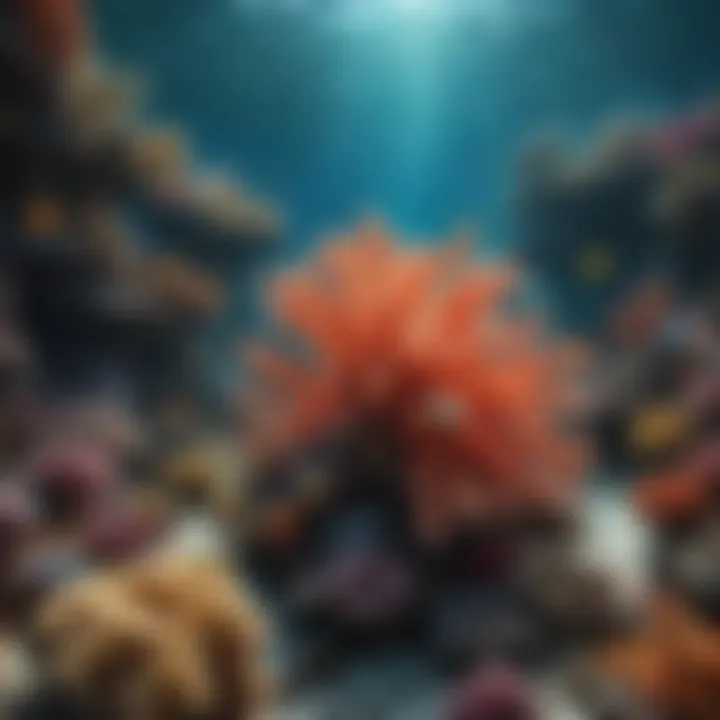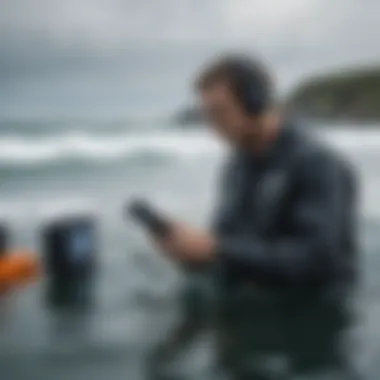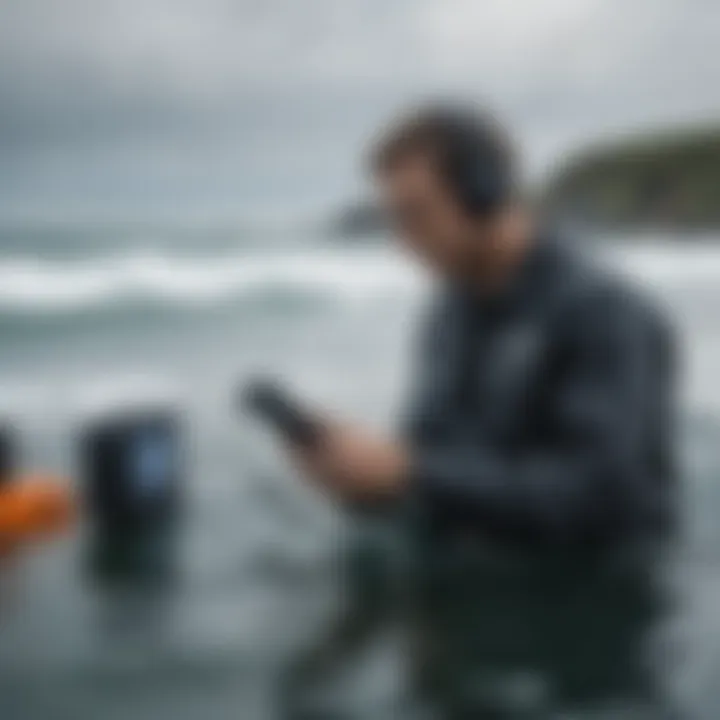Exploring the Rich Soundscape of the Ocean


Intro
The ocean is far more than a body of water; it is a living, breathing entity full of life and sounds. Beyond the aesthetics of a gentle tide rolling onto the shore or the crash of waves in a storm, there exists a rich tapestry of audio experiences that shape our perception of marine environments. This
acoustic wonderland transforms our emotional states, impacts our mental well-being, and influences various activities on and near the water.
Listening to the ocean is like reading a language that tells stories of distance, depth, and time. Every splash, call, and gust contributes to layered soundscapes that can evoke a myriad of feelings, from serenity to excitement. For the novice beachgoer, the sound might just be background noise. In contrast, for dedicated enthusiasts and professionals, it's a complex blend full of hidden meanings and potential for deeper connection.
In this exploration, we’ll uncover how these natural symphonies affect mental health, drive outdoor pursuits, and necessitate consideration in sports, recreation, and conservation. The journey through the oceanic soundscape offers insights not only into the nature of sound itself but its broader implications for human experience.
Understanding Ocean Sounds
Sound is everywhere, but perhaps nowhere is it more nuanced and rich than in the ocean. Understanding ocean sounds is not just a scholarly pursuit; it’s an essential aspect of appreciating the marine environment in its entirety. As we dive into what these sounds convey, we can appreciate the various layers of life and interaction that occur beneath the surface. This section lays the groundwork for exploring the broader implications and significance of these underwater acoustic phenomena.
Defining Ocean Sounds
Ocean sounds can be defined as the myriad of auditory phenomena produced in marine environments. These vary from the rhythmic crashing of waves against rocky shores to the haunting calls of dolphins echoing through the deep. It's not just about distinguishing between noise and music; rather, it's about understanding their role in ecological and cultural contexts.
- Natural Sounds: Wave action creates a constant backdrop, while marine life contributes a symphony—a blend of clicks, whistles, and songs. Seals barking and fish spawning add to the cacophony.
- Anthropogenic Sounds: Human activities also introduce various sounds into the marine environment. Boating, shipping, and sonar create auditory signals that can interfere with those produced by marine life.
In essence, ocean sounds form a distinct language that communicates the health and dynamics of marine ecosystems.
The Role of Sound in Marine Environments
Sound plays several crucial roles in marine environments. Here are some key points worth noting:
- Communication: Many marine species rely on sound to communicate. For example, humpback whales are known for their long and melodious songs, which can travel great distances underwater. This capability enables not only social interaction but also reproductive signaling.
- Navigation: Many species use sound for navigation, particularly in darker or murkier waters. Dolphins utilize echolocation to locate prey and avoid obstacles, showcasing an incredible adaptation to their environment.
- Ecosystem Dynamics: The presence and types of sounds can indicate the health of an ecosystem. Areas filled with vibrant marine life are often accompanied by rich soundscapes, while silence may indicate a stressed or dying habitat.
"The ocean, with its rich tapestry of sound, tells a story of life and loss, communication and conflict."
In summary, understanding ocean sounds encompasses more than mere definitions or classifications. It involves recognizing the integral role they play in the survival of marine species, the stability of ecosystems, and even human enjoyment and mental well-being. As we progress in our exploration of ocean sounds, it's imperative to keep in mind their underlying significance in both natural phenomena and human activities.
Types of Ocean Sounds
The ocean isn’t just a vast expanse of water; it's a living entity filled with sounds that resonate through its depths. Understanding and exploring these sounds is crucial for anyone looking to dive into marine environments or simply appreciate the natural world. They reveal important insights about the ocean's health, the life it supports, and even how we engage in recreational activities. Ultimately, a keen awareness of ocean sounds enhances both our understanding of marine ecosystems and our personal experiences within them.
Natural Sound Sources
Wave Dynamics
Wave dynamics form the backbone of the ocean’s soundscape. As waves crash against the shore or ripple through open water, they generate a complex symphony of sounds. These can range from the soothing whispers of gentle waves to the thunderous roars of crashing surf. The key characteristic of wave dynamics is their variability; each wave is unique and can change based on wind, underwater topography, and current conditions. This makes them a popular feature in discussions about ocean sounds, as they provide a constant backdrop, grounding us in the aquatic world.
An interesting feature of wave dynamics is their ability to convey mood. Calm waves often evoke feelings of serenity, while stormier conditions may raise alarm or unease. In practical terms, recording these sounds can benefit relaxation techniques and therapies, helping to create peaceful environments. However, one must also consider their unpredictable nature—audiences or those involved in watersports must adapt to the sounds of waves as they respond to changing conditions.
Marine Life Calls
Marine life calls add an incredible depth to the ocean’s auditory landscape. From the long, low calls of whales to the quick clicks and whistles of dolphins, these sounds are essential for communication among marine species. The prominence of marine life calls in this article highlights their importance, particularly in understanding social structures and behaviors of these creatures.
One key aspect of marine life calls is their role in navigation and hunting. For instance, many species use echolocation to locate food or mates. The unique patterns and frequencies of these calls not only serve functional purposes but also create a rich tapestry of noise that enhances marine environments. On the downside, increasing human activity frequently disrupts these natural sounds, making it challenging for marine animals to communicate effectively.
Human-Related Sounds
Humans have left their mark on ocean sounds; distinct noise pollution is a consideration that's becoming increasingly relevant. Human-related sounds include ship traffic, underwater construction, and even recreational activities like motorboats or jet skis. While these sounds are often viewed negatively because they can interfere with marine life interactions, they also serve as a reflection of our presence in these environments.
The key characteristic of human-related sounds is their omnipresence—whether we acknowledge it or not, they shape the acoustic landscape of the ocean. This context is vital in this article since it presents an opportunity to discuss how we can balance our activities with the need to preserve marine life. For instance, adopting quieter technologies and practices can contribute to reducing our auditory footprint. Yet, it's crucial to acknowledge that some sounds are necessary for safety and can sometimes enhance activities, bringing attention to the importance of responsible ocean stewardship.
Characteristics of Ocean Sounds
Frequency and Wavelength
When we think about ocean sounds, frequency and wavelength are paramount. These two characteristics help determine how we perceive sound. Lower frequencies travel further and are typically below the level of human hearing, making them vital for marine mammals that communicate over long distances. This aspect makes frequency and wavelength a focal point when exploring the ocean soundscape.
Their unique feature lies in the way they shape the perception of sounds—different species have adapted to different frequency ranges. For humans, understanding these aspects can be beneficial, particularly when engaging in activities like snorkeling or diving, where awareness of underwater noises can enhance the experience. On the negative side, loud noises, particularly in shallow waters, can mask the sounds that marine creatures depend on, leading to disorientation and stress among species.


Volume Variations
Volume variations in ocean sounds contribute significantly to how we engage with marine environments. Sound levels can fluctuate greatly due to numerous factors, including wind speed or undercurrents. This variability is crucial for understanding not only the acoustics of the ocean but also the experiences of those within it.
A unique dimension here is how volume can influence marine life behavior. For example, louder sounds can induce stress responses in animals, while quieter moments allow for calm and communication. The challenge lies in integrating these insights into practices that consider both recreational use and ecological balance, ensuring that our interactions do not overwhelm the natural soundscape.
Temporal Patterns
Temporal patterns encapsulate the rhythms and cycles of ocean sounds. These patterns offer a deeper understanding of acoustic environments, revealing not just the chaos of nature but also its harmony. Sounds such as mating calls, feeding cries, or even the ebb and flow of waves create a cadence that defines marine life.
The importance of temporal patterns in this article lies in their ability to illustrate the interconnectedness of marine species. Recognizing these patterns can improve our understanding of breeding seasons or feeding times, which can better inform conservation efforts or recreational planning. However, the downside includes challenges from disruption, as any unnatural interference can alter these patterns, having significant impacts on animal behaviors and ecosystem health.
In understanding ocean sounds, we not only appreciate the beauty of marine environments but also recognize our role in preserving these diverse auditory landscapes.
By delving into the diverse types of ocean sounds, their nuances and the balance they play in our life, we open a door to a greater appreciation and responsibility for our oceans.
Ocean Sounds and Mental Well-Being
When we consider the multitude of elements that shape our mental health, the soundscapes of the ocean often don’t come to mind immediately. Yet, these sounds offer a unique layer of emotional comfort that can significantly impact our well-being. It’s not just about hearing the waves crash; it’s about embracing the tranquility and rhythm of the ocean that resonates with our inner selves. This section explores how ocean sounds can act as a powerful tool for enhancing mental well-being across various dimensions.
The Therapeutic Effects of Natural Sounds
Stress Reduction
Stress can feel like a relentless wave crashing against the shore of our daily lives. Ocean sounds, like the gentle lull of waves lapping at the beach, offer a refuge. They create an auditory escape that allows us a moment's reprieve from the chaos in our minds. The key characteristic of stress reduction through these natural sounds lies in their ability to promote relaxation. Listening to ocean waves can lower cortisol levels, leading us to Feel calmer.
A unique aspect of this stress-reducing feature is the way it syncs with our natural physiological responses. As we listen to these soothing sounds, our heart rates may stabilize, and our breathing becomes slower and deeper. However, while many find this calming, some individuals might not respond well. They might feel distracted by the unpredictability of marine sounds. Still, the overwhelming evidence supporting ocean sound as a beneficial remedy for stress is hard to overlook.
Enhanced Focus
When it comes to concentration, many find the buzz of a bustling café or the hum of white noise helpful. Yet there is something remarkably unique about the sounds of the ocean. The rhythmic nature of waves crashing on the shore can actually sharpen our focus. This trait stems from the ambient quality of ocean sounds, which effectively drowns out distractions while still being pleasant.
This enhanced focus is instrumental for those engaging in tasks that require deep thinking or creativity. The gentle sea sounds encourage a flow state that can boost productivity. Nevertheless, not everyone may find it effective; for some, ocean sounds might evoke memories of relaxation, making it harder to concentrate. It’s fascinating how our individual experiences shape our perceptions of the same sound.
Sleep Improvement
In a world where sleep deprivation becomes the norm, ocean sounds can serve as a gentle nudge toward restfulness. The characteristic calming effect of ocean waves can lull individuals into a deeper sleep, thanks to their predictability and rhythmic cadence. Many people have adopted the use of ocean sound recordings as part of their bedtime routine, discovering that they can ease the transition into slumber.
One notable feature of this sleep-enhancing soundscape is its ability to mask disturbances. Unexpected noises from neighbors, traffic, or even creaking floors from an older home become less intrusive when the soothing sound of the ocean fills the air. However, while many enjoy this nighttime companion, a few might find that the sounds evoke vivid dreams of past beach vacations, making sleep less restful. This highlights the subjective nature of ocean sounds and their effectiveness for sleep improvement.
Creating Ambient Spaces
Home Soundscapes
Crafting a sound environment at home can be quite transformative. Home soundscapes that incorporate ocean sounds can create a peaceful retreat away from the daily grind. This aspect allows individuals to bring the ocean’s serenity indoors, ideally fostering a serene atmosphere conducive to relaxation or productivity.
The key characteristic that makes home soundscapes beneficial is their adaptability. They can be seamlessly integrated into various rooms, whether it’s a soothing ambiance in a bedroom or a tranquil backdrop in a home office. However, one must consider that continuous exposure to these sounds could lead to desensitization; over time, the calming effect might diminish. This calls for variety in sound choices to maintain their energizing essence.
Nature-Inspired Environments
The power of nature-inspired environments extends beyond the auditory world. Integrating ocean sounds into physical spaces—like yoga studios, wellness centers, or homes—can significantly enhance the atmosphere. This approach guides individuals toward a connection with nature that might otherwise remain elusive in urban settings. The ambient sounds of the ocean create a serene setting that resonates emotionally with many.
What makes these environments particularly appealing is their ability to evoke a sense of place, a reminder of tranquil beach moments. Nevertheless, crafting such an environment requires careful curation, balancing sounds with silence. Too much sound can overwhelm the senses, detracting from the peaceful experience that ocean sounds are meant to provide.
Utilizing ocean sounds for mental well-being not only enriches one's emotional state but also fosters a connection back to nature, reminding us of the profound tranquility that can be found in the waves.
Through understanding the many dimensions of ocean sounds and their relation to mental well-being, listeners can explore an impressive spectrum of benefits for themselves. Whether it’s less stress, improved focus, or better sleep, integrating ocean sounds into daily life can serve as a powerful catalyst for an enhanced state of mind.
Incorporating Ocean Sounds into Watersports
The integration of ocean acoustics into watersports adds layers of experience that go beyond physical engagement. Sound plays a pivotal role in the way that participants experience and navigate through activities like surfing, kayaking, and sailing. It’s not just about the thrill of the ride; it’s also about how these sonic elements sculpt one’s emotional and mental landscape during these endeavors.
Enhancing the Sporting Experience


Sound as a Performance Modifier
Sound can significantly enhance an athlete's performance in watersports. Whether it’s the rhythm of crashing waves or the calls of marine life, these natural sounds can set the pace for a swimmer or surfer. The subtle variations in sound can even help individuals gauge their speed or the proximity of obstacles.
A fascinating characteristic of sound as a performance modifier is its ability to synchronize with movement. For instance, surfers often find themselves timing their paddles with the rhythm of the waves breaking. This interaction can transform a challenging surf session into a more harmonious performance, leading to better outcomes. Interestingly, it is this blend of auditory feedback and physical movement that often becomes a cornerstone of a seasoned athlete’s edge.
However, it’s worth noting that not all sounds are beneficial. Distracting noises, perhaps an overzealous crowd or a nearby motorboat, can disrupt focus, leading to less optimal performance. Thus, recognizing the right sounds to embrace and the ones to block out can make all the difference.
Focus and Concentration while Surfing
Concentration is often the fine line between a satisfying experience and a challenging one. When surfing, balance and mindfulness are paramount. The sounds of the ocean serve as a natural backdrop that can enhance one’s focus. Imagine the steady pulse of waves lapping against a board; it closely mimics the heartbeat, encouraging a meditative state.
This unique feature allows surfers to engage not just with the ocean, but also with their own bodies in a deep, almost symbiotic manner. The key here lies in how the auditory landscape influences mental clarity. When a surfer becomes attuned to the sounds surrounding them, there's a greater chance for improved decisions - when to ride, when to duck under a wave, or when to paddle harder.
While relying on sound for concentration proves effective, it might also have downsides. For instance, someone new to surfing may become overwhelmed by the variety of sounds, making it harder to focus on the single-minded task of riding the wave. Thus, while sound enhances concentration, the ability to filter and focus on relevant sounds is a skill that can take time to develop.
Sound and Safety
Sound is not only a critical element for performance but also acts as an essential safety feature in watersports. Listening attentively to the environment can determine an athlete's safety and helps to avoid potential dangers associated with ocean activities.
Listening for Natural Indicators
The practice of carefully listening for natural indicators is fundamental for anyone venturing into the water. For instance, the sound of currents and tidal changes can serve as a warning signal, alerting watermen and women about shifting conditions. Experienced surfers and divers often rely on these sounds to gauge the upcoming risks in their environment.
The key characteristic here is the immediate response generated by natural sounds. When someone hears the abrupt change in wave frequency, they instinctively understand the need to adjust their position or technique. This instinctual response showcases why auditory cues can be more reliable than visual ones in certain situations.
Yet, depending solely on sound does come with its challenges. For instance, environmental noise, like wind or boat engines, can mask critical sounds, making it harder to respond effectively. Training oneself to be attuned to these natural indicators is crucial for maintaining safety.
Communication in Water Activities
In watersports, communication often takes a different form compared to land-based activities. Utilizing sound—human voices, whistles, or even hand signals—can establish clarity. This unique arrangement ensures that instructions are communicated despite the potential of distorting acoustic signals due to the surrounding nature.
The characteristic of effective communication relies on sound clarity over distance and environmental distractions. In busy areas, perhaps near a beach or a river convergence, shouting can get lost easily among competing sounds. Thus, refining clear signals becomes important for safety and achieving group objectives on the water.
The advantage of prioritizing communication via sound lies in its immediacy. When every second counts, being able to convey information swiftly, whether it's a warning or a cue for teamwork, creates a seamless operational flow. However, on the flip side, communication can become tricky in certain conditions. High winds and turbulent waters may distort voices, leading to misunderstandings that could jeopardize safety in challenging situations.
Technology and Ocean Sounds
The intersection of technology and ocean sounds manifests in various fascinating ways, enhancing our understanding of marine environments. The role of technology in this realm isn't just a modern convenience; it's a crucial component in capturing, analyzing, and disseminating the rich aural tapestry of the ocean. By leveraging sophisticated tools and methods, researchers and enthusiasts alike can delve into the intricate soundscape of the seas, providing valuable insights into ecological health and vibrant marine life.
Recording Marine Sounds
Methods of Capture
When it comes to capturing the myriad sounds beneath the waves, multiple methodologies exist, each tailored to the specific environment and purpose. Hydrophones stand out as the primary instruments used in this endeavor. These underwater microphones convert water-borne sound waves into electrical signals, making it possible to record everything from the peaceful lapping of waves to the complex communications of dolphins. One key characteristic of using hydrophones is their ability to capture sounds across a vast frequency range, crucial for understanding different marine species' acoustics.
A unique feature of hydrophone setups is that they can be deployed in various ways—stationary buoys, autonomous underwater vehicles, or even integrated into established oceanographic devices like research submarines. One advantage of this flexibility is that researchers can gather continuous data over extended periods, an important factor in studying phenomena such as population dynamics of marine animals or changes in their habitats. However, a potential drawback includes the complexity of calibrating these devices to ensure accuracy across varying depths and water conditions.
Challenges in Recording
Recording marine sounds does not come without its hurdles. Among the primary challenges in recording ocean sounds is the high level of interference from environmental noise. From bustling boat traffic to natural sounds like storms, the clarity of the sound can be drastically affected. These external factors can muddy the waters, making it difficult to distinguish between anthropogenic and natural sounds.
Additionally, the vastness of the ocean can create logistical nightmares when attempting to deploy recording equipment. The unique feature of sound propagation in marine environments—where sound travels over long distances—poses its own set of challenges. Often, signals become garbled before they reach the receivers, complicating analysis. This is particularly significant in terms of behavioral studies, as the nuances of sound communication are vital in understanding animal interactions.
Digital Soundscapes
Creating Soundscapes for Meditation
Creating soundscapes for meditation involves the art of blending oceanic sounds with mindfulness practices, offering a therapeutic experience for listeners. With a key characteristic of evoking relaxation, these curated auditory environments can transport individuals away from the hustle of daily life. The gentle rhythm of ocean waves, interspersed with distant seabird calls, creates a sense of tranquility.
A standout feature of this approach is how natural sounds aid in grounding listeners, providing a more profound sense of connection with nature. Such sounds can enhance meditation practices by helping individuals reach deeper states of focus. However, a disadvantage might be that not everyone responds positively to ocean sounds, as personal preferences vary widely.
Apps that Feature Ocean Sounds


The rise of technology has birthed a plethora of apps dedicated to ocean sounds, bringing blends of serene seascapes into the daily lives of users. One compelling aspect of these apps is their accessibility; anyone with a smartphone can tap into the soothing sounds of the sea, which can be particularly beneficial for users seeking environment-enhancing backgrounds for work or relaxation.
The unique feature of many of these apps is their variety and customizability. Users can often mix sounds—like gentle rain with breaking waves—to create their preferred auditory atmosphere. However, some may find it challenging to replicate the authenticity of real ocean sounds digitally; this can detract from the immersive experience they aim to provide.
"Capturing the soundscape of the ocean is not just about documentation; it's about experiencing its profound impact on our lives."
The integration of technology into the understanding of ocean sounds has opened up numerous possibilities, providing critical tools for researchers and offering unique experiences for anyone interested in the sounds of the sea.
Cultural Perspectives on Ocean Sounds
The ocean, much like the echoes it gives birth to, has forever held a peculiar sway over human culture. The sounds generated by its waves, creatures, and currents infuse meaning into everything from ancient mythologies to contemporary celebrations. Understanding how different cultures have woven these sounds into their narratives and practices helps to appreciate the broader significance of marine acoustics beyond mere entertainment.
In this section, let's explore how traditional and modern societies resonate with the ocean's melodies, and how those meanings translate into a richer understanding of our relationship with this expansive body of water.
Traditional Uses of Marine Sounds
Myths and Folklore
Across the globe, ocean sounds have sparked imaginations. Take the rhythmic crash of waves, for instance; it often symbolizes the heartbeat of the earth in various mythologies. Many cultures have woven tales of great sea creatures or spirits whose voices echo in the roaring surf. This aspect of marine sounds not only embellishes storytelling but also creates a profound connection with nature.
A key characteristic of these myths is that they often personify the ocean. The stories shared around a campfire or a hearth showcase the respect and awe that different communities hold for the sea. In ways, these narratives serve as cautionary tales, warning generations of the potential dangers that lie beneath the beautiful surface of the water. But beyond that, they promote a sense of unity with the natural world, a theme that's increasingly relevant today.
One unique feature of these myths is their ability to resonate through ages. While some tales may fade over time, the mesmerizing sounds of the ocean remain constant, reinforcing these folklore narratives. This continuity serves as an anchor in cultural identity. However, one disadvantage might be that some of these sound-related myths may contribute to misunderstandings about the ocean's ecological realities.
Cultural Celebrations
In various coastal communities, ocean sounds play a pivotal role in cultural celebrations. The distinctive characteristics of these celebrations range from seasonal festivals honoring the ocean to rituals aimed at ensuring a bountiful catch. The sounds of waves accompanied by songs of fishermen or the chants of local tribes create a lively ambiance during festival times.
One of the most beneficial aspects of incorporating marine sounds into cultural celebrations is the way it fosters community spirit. Groups come together, sharing not only food and festivities, but also a collective experience underscored by the ocean's music. Whether it's the gentle lapping of water or the booming of surf, these sounds unite people, reminding them of their shared heritage.
However, a challenge arises when trying to maintain these traditions in increasingly urbanized areas. As urban environments encroach upon coastal lands, the sounds that have filled the air for generations can be overshadowed by man-made noises. This clash raises questions about cultural preservation and the need to innovate new ways to celebrate while honoring traditional marine sounds.
The Modern Appreciation of Ocean Sounds
Sound Art
In contemporary art scenes, sound art has emerged as a brilliant medium, exploring not only visual aspects but also the auditory experience of the ocean. This aspect highlights an innovative approach to engaging with marine sounds. Artists capture the essence of oceanic sounds and repurpose them into installations that challenge perceptions of both sound and environment.
A key characteristic of sound art is its focus on immersion. Through techniques like soundscaping, artists transport listeners to the ocean without them ever leaving their seats, creating profound emotional connections. This makes it a popular choice in galleries, as visitors seek new ways to experience art that transcends mere visuals.
The unique feature of sound art is its ability to convey stories without language. Ocean sounds tell tales of beauty, danger, and vastness, treasured as both a source of inspiration and a reminder of what is at stake ecologically. However, a downside may lie in the accessibility of these experiences; not everyone may relate or connect with art forms that depend solely on auditory stimuli.
Documentaries and Media
Documentaries increasingly highlight the significance of ocean sounds, showcasing their beauty while shedding light on environmental issues. This aspect serves as an important educational tool, merging visuals and sounds to emphasize the delicate balance of marine ecosystems.
A key characteristic of these documentaries is their capacity to evoke emotional responses, making complex ecological narratives accessible to a broader audience. Through the harmonious blend of visual storytelling and oceanic soundscapes, viewers can develop a deeper appreciation for marine life. This makes it a beneficial choice not only for entertainment but for awareness and advocacy.
One unique feature lies in the careful production of soundscapes that accompany these films. The lifting calls of whales or the rhythmic crashing of waves augment the visuals, making environmental messages more poignant. Yet, there is a challenge to balance artistry and factual representation; environmental documentaries must strive to maintain accuracy while still captivating audience attention, to avoid sensationalism.
Closure
The acoustic panorama of the ocean is a topic of immense significance in our modern understanding of marine environments and human interaction with them. By reflecting on the acoustic diversity present beneath the waves, we begin to acknowledge how much these sounds shape not only the natural ecosystem but also our emotional and psychological landscapes.
Reflections on the Ocean’s Acoustic Diversity
The sounds that emanate from the ocean are a rich tapestry woven from various threads, each representing distinct facets of marine life and processes. From the rhythmic crash of the waves against rocky shores to the haunting calls of whales echoing across vast distances, this acoustic diversity serves multiple purposes. It acts as a communication channel for marine animals—think of the intricate dances of dolphins and their use of echolocation. It also resonates with those of us on land, bringing with it memories and emotions tied to experiences on the water.
Especially for sports enthusiasts and adventure seekers, understanding this sonic landscape heightens appreciation for activities like surfing, sailing, or diving. For example, consider how the gentle, stealthy sounds of a distant storm can change the atmosphere entirely, alerting a sailor to possible danger. We become aware that ocean sounds are not just background noise; they are vital indicators that inform our decisions and experiences.
Ultimately, the various layers of ocean sounds beckon us to listen—each sound tells a story about the health of marine environments, our relationship to those spaces, and our need to preserve them for future generations.
Encouragement for Active Engagement
Engaging with the ocean's soundscape should not be limited to passive listening; it requires a proactive approach. Whether you are a coach instructing athletes on water dynamics or a marketer promoting ocean-inspired products, there's value in understanding and sharing the intricacies of these sounds. In practice, this might mean encouraging athletes to attune themselves to their marine surroundings, fostering not just a connection to their sport but also a deeper understanding of environmental cues that could enhance safety and performance.
Moreover, in the digital age, many tools and resources are at our fingertips. Apps like Ocean Waves or Marine Soundscapes offer ambient sound experiences that can be incorporated into mindfulness or meditation practices, allowing users to bring a piece of the ocean into their daily lives, irrespective of their physical location.
"The ocean's voice is not just for the creatures that dwell within it; it's for all of us to hear and engage with, to learn from and protect."
By advocating for and participating in active listening initiatives—whether through workshops, community events, or personal mindfulness practices—we cultivate a culture that respects and values the natural symphony unfolding beneath the surface.







